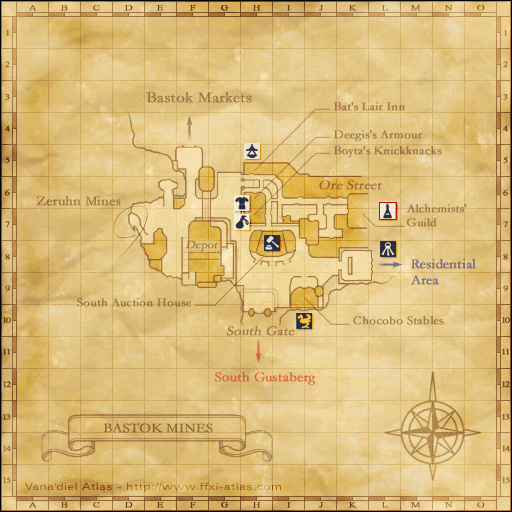Cermet Chunk
Statistics
Other Uses
| Guild Points Value: None |
| Used in Quests: |
| Resale Price: 500~512 gil |
| Guild Resale Price: ~750 gil |
Synthesis Recipes
- Yield: Cermet Chunk x 1
HQ 1: Cermet Chunk x 2
HQ 2: Cermet Chunk x 3
HQ 3: Cermet Chunk x 4 - Fire Crystal
- 4 x Magic Pot Shard
HQ 1: Cermet Chunk x 2
HQ 2: Cermet Chunk x 3
HQ 3: Cermet Chunk x 4
- 2 x Golem Shard
HQ 1: Cermet Chunk x 2
HQ 2: Cermet Chunk x 3
HQ 3: Cermet Chunk x 4
- 2 x Doll Shard
Used in Recipes
 59
59  09
09  48 Leucos Voulge
48 Leucos Voulge
 62 Cermet Knife
62 Cermet Knife
 63
63  16 Cermet Claws
16 Cermet Claws
 65
65  08 Ice Arrow
08 Ice Arrow
 66
66  06 Battery
06 Battery
 66
66  39 Hanger
39 Hanger
 68 Cermet Sword
68 Cermet Sword
 70 Saber
70 Saber
 73
73  45 Cutlass
45 Cutlass
 75 Cermet Kukri
75 Cermet Kukri
 76
76  18 Kilo Battery
18 Kilo Battery
 76 Halcyon Rod
76 Halcyon Rod
 78
78  29 Jamadhars
29 Jamadhars
 86
86  31
31  16 Mega Battery
16 Mega Battery
 90 Espadon
90 Espadon
 64
64  40
40  57 Hosodachi
57 Hosodachi
 71
71  51 Gold Cuisses
51 Gold Cuisses
 72
72  54 Gold Armet
54 Gold Armet
 74
74  54 Gold Sabatons
54 Gold Sabatons
 77
77  54 Gold Gauntlets
54 Gold Gauntlets
 78
78  ?? Gold Cuirass
?? Gold Cuirass
 93
93  ?? Cursed Diechlings
?? Cursed Diechlings
 94
94  ?? Cursed Schuhs
?? Cursed Schuhs
 96
96  ?? Cursed Handschuhs
?? Cursed Handschuhs
 97
97  ??
??  ?? Cursed Schaller
?? Cursed Schaller
 98
98  ?? Cursed Cuirass
?? Cursed Cuirass
 63
63  51
51  ?? Sakurafubuki
?? Sakurafubuki
 71
71  56
56  ?? Schwert
?? Schwert
 86
86  57 Cermet Lance
57 Cermet Lance
Desynthesis Recipes
None
Obtained from Desynthesis
 90 Espadon
90 Espadon
 71 Gold Cuisses
71 Gold Cuisses
 93 Ice Lance
93 Ice Lance
How to Obtain
Auction House Category: Materials > Alchemy ![]()
Merchants
| Price: 5,000 gil | ||
| Name | Location | Type |
|---|---|---|
| Odoba |
Bastok Mines (K-6) | Alchemists' Guild |
Quests
- Strange Apparatus The Cermet Chunk is one possible reward for completing this mini-quest.
The Chocobo Hot and Cold Game
| Zone | Abundance |
|---|---|
| Valkurm Dunes | |
| Buburimu Peninsula |
Historical Background
A cermet is a composite material composed of ceramic (cer) and metallic (met) materials. A cermet is ideally designed to have the optimal properties of both a ceramic, such as high temperature resistance and hardness, and those of a metal, such as the ability to undergo plastic deformation. The metal is used as a binder for an oxide, boride, carbide, or alumina. Generally, the metallic elements used are nickel, molybdenum, and cobalt.
Depending on the physical structure of the material, cermets can also be metal matrix composites, but cermets are usually less than 20% metal by volume. Cermets are used in the manufacture of resistors (especially potentiometers), capacitors, and other electronic components which may experience high temperatures. In the tool world, tungsten carbide is considered a cermet although tungsten carbide is so widely used that it is considered a class by itself. Cermets are being used instead of tungsten carbide in saws and other brazed tools due to their superior wear and corrosion properties. TiCN, TiC, TiN and similar can be brazed like tungsten carbide if properly prepared however they require special handling during grinding. More complex materials, known as Cermet 2 or Cermet II, are being utilized since they give considerably longer life in cutting tools while both brazing and grinding like tungsten carbide. Some types of cermets are also being considered for use as spacecraft shielding as they resist the high velocity impacts of micrometeoroids and orbital debris much more effectively than more traditional spacecraft materials such as aluminum and other metals.
After World War II, the need to develop high temperature and high stress-resistant materials in the US became clear. During the war, German scientists developed oxide base cermets as substitutes for alloys. They saw a use for this for the high-temperature sections of new jet engines as well as high temperature turbine blades.
Today ceramics are routinely implemented in the combuster part of jet engines because it provides a heat resistant chamber. Ceramic turbine blades have also been developed. These blades are lighter than steel and allow for greater acceleration of the blade assemblies. The United States Air Force saw potential in the material technology and became one of the principal sponsors for various research programs in the US. Some of the first universities to research were Ohio State University, University of Illinois, and Rutgers University. The word cermet was actually coined by the United States Air Force, the idea being that they are a combination of two materials, a metal and a ceramic. Basic physical properties of metals include ductility, high strength, and high thermal conductivity. Ceramics possess basic physical properties such as a high melting point, chemical stability, and especially oxidation resistance.
The first ceramic metal material developed used magnesium oxide (MgO), Beryllium oxide (BeO), and aluminum oxide (Al2O3) for the ceramic part. Emphasis on high stress rupture strengths was around 980C.[2] Ohio State University was the first to develop Al2O3 based cermets with high stress rupture strengths around 1200C. Kennametal, a metal-working and tool company based in Latrobe, PA, developed the first titanium carbide cermet with a 2800 psi and 100 hour stress-to-rupture strength at 980C. Jet engines operate at this temperature and further research was invested on using these materials for components.
Quality control in manufacturing these ceramic metal composites was hard to standardize. Production had to be kept to small batches and within these batches, the properties varied greatly. Failure of the material was usually a result of undetected flaws usually nucleated during processing. The existing technology in the 1950s reached a limit for jet engines where little more could be improved. Subsequently, engine manufactures were reluctant to develop ceramic metal engines. Interest was renewed in the 1960s when silicon nitride and silicon carbide were looked at more closely. Both materials possessed better thermal shock resistance, high strength, and moderate thermal conductivity.


